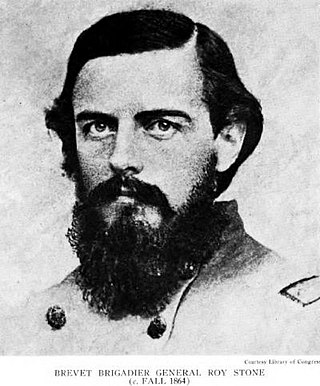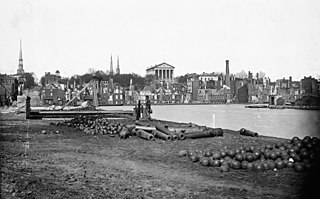USS Richard Vaux (1864), a 120-ton canal boat, was purchased by the Union Navy at Philadelphia, Pennsylvania, 16 July 1864, for use as part of the "stone fleet" of obstructions in the waterways of the Confederate States of America during the American Civil War.
Richard Vaux was laden with stone, and sent via Baltimore, Maryland, to the James River to be sunk on the bar at Trent's Reach, Virginia, to protect Union troops from Confederate attack by water.

The American Civil War was a civil war in the United States between the Union and the Confederacy, which had been formed by states that had seceded from the Union. The cause of the war was the dispute over whether slavery would be permitted to expand into the western territories, leading to more slave states, or be prevented from doing so, which many believed would place slavery on a course of ultimate extinction.

In the 1860s, the Copperheads, also known as Peace Democrats, were a faction of the Democratic Party in the Union who opposed the American Civil War and wanted an immediate peace settlement with the Confederates.

The Battle of Mansfield, also known as the Battle of Sabine Crossroads, on April 8, 1864, in Louisiana formed part of the Red River Campaign during the American Civil War, when Union forces were attempting to occupy the Louisiana state capital, Shreveport.

In the context of the American Civil War (1861–65), the border states were slave states that did not secede from the Union. They were Delaware, Maryland, Kentucky, and Missouri, and after 1863, the new state of West Virginia. To their north they bordered free states of the Union, and all but Delaware bordered slave states of the Confederacy to their south.

The Battle of Nashville was a two-day battle in the Franklin-Nashville Campaign that represented the end of large-scale fighting west of the coastal states in the American Civil War. It was fought at Nashville, Tennessee, on December 15–16, 1864, between the Confederate Army of Tennessee under Lieutenant General John Bell Hood and the Union Army of the Cumberland (AoC) under Major General George H. Thomas. In one of the largest victories achieved by the Union Army during the war, Thomas attacked and routed Hood's army, largely destroying it as an effective fighting force.

The Battle of Chaffin's Farm and New Market Heights, also known as Laurel Hill and combats at Forts Harrison, Johnson, and Gilmer, was fought in Virginia on September 29–30, 1864, as part of the siege of Petersburg in the American Civil War.

Robert EmmettRodes was a Confederate general in the American Civil War, and the first of Robert E. Lee's divisional commanders not trained at West Point. His division led Stonewall Jackson's devastating surprise attack at the Battle of Chancellorsville; Jackson, on his deathbed, recommended that Rodes be promoted to major general. Rodes then served in the corps of Richard S. Ewell at the Battle of Gettysburg and in the Overland Campaign, before that corps was sent to the Shenandoah Valley under Jubal Early, where Rodes was killed at the Third Battle of Winchester.

John White Stevenson was the 25th governor of Kentucky and represented the state in both houses of the U.S. Congress. The son of former Speaker of the House and U.S. diplomat Andrew Stevenson, John Stevenson graduated from the University of Virginia in 1832 and studied law under his cousin, future Congressman Willoughby Newton. After briefly practicing law in Mississippi, he relocated to Covington, Kentucky, and was elected county attorney. After serving in the Kentucky legislature, he was chosen as a delegate to the state's third constitutional convention in 1849 and was one of three commissioners charged with revising its code of laws, a task finished in 1854. A Democrat, he was elected to two consecutive terms in the U.S. House of Representatives where he supported several proposed compromises to avert the Civil War and blamed the Radical Republicans for their failure.

The Battle of Pleasant Hill occurred on April 9, 1864 and formed part of the Red River Campaign during the American Civil War when Union forces aimed to occupy the Louisiana state capital, Shreveport.

Roy Stone was an American soldier, civil engineer, and inventor. He served in the American Civil War, distinguishing himself during the Battle of Gettysburg, and took part in the Spanish–American War. He pursued a civil engineering career in a peacetime and became in 1893 the first head of the Office of Road Inquiry, which was the Federal Highway Administration's predecessor.

Stephen Gano Burbridge, also known as "Butcher" Burbridge or the "Butcher of Kentucky", was a controversial Union general during the American Civil War. In June 1864 he was given command over the Commonwealth of Kentucky, where guerrillas had carried out attacks against Unionists. He imposed martial law and was criticized for punitive actions against persons accused of being guerrillas.

The Colorado Territory was formally created in 1861 shortly before the bombardment of Fort Sumter sparked the American Civil War. Although sentiments were somewhat divided in the early days of the war, Colorado was only marginally a pro-Union territory. Colorado was strategically important to both the Union and Confederacy because of the gold and silver mines there as both sides wanted to use the mineral wealth to help finance the war. The New Mexico Campaign was a military operation conducted by Confederate Brigadier General Henry Sibley to gain control of the Southwest, including the gold fields of Colorado, the mineral-rich territory of Nevada and the ports of California. The campaign was intended as a prelude to an invasion of the Colorado Territory and an attempt to cut the supply lines between California and the rest of the Union. However, the Confederates were defeated at the Battle of Glorieta Pass in New Mexico and were forced to retreat back to Texas, effectively ending the New Mexico Campaign.

Richmond, Virginia served as the capital of the Confederate States of America during the American Civil War from May 8, 1861, hitherto the capital had been Montgomery, Alabama. Notwithstanding its political status, it was a vital source of weapons and supplies for the war effort, as well as the terminus of five railroads, and as such would have been defended by the Confederate States Army at all costs.
The following outline is provided as an overview of and topical guide to the American Civil War:

The general officers of the Confederate States Army (CSA) were the senior military leaders of the Confederate States of America during the American Civil War of 1861–1865. They were often former officers from the United States Army before the Civil War, while others were given the rank based on merit or when necessity demanded. Most Confederate generals needed confirmation from the Confederate States Congress, much like prospective generals in the modern U.S. armed forces.

As a fervently abolitionist and strongly Republican state, Maine contributed a higher proportion of its citizens to the Union armies than any other, as well as supplying money, equipment and stores. No land battles were fought in Maine. The only episode was the Battle of Portland Harbor (1863) that saw a Confederate raiding party thwarted in its attempt to capture a revenue cutter.
The Battle of Massard Prairie was a battle fought on July 27, 1864 in Sebastian County, Arkansas during the American Civil War. Confederate troops led by Brigadier-General Richard M. Gano successfully launched a surprise attack on a Union camp held by four companies of the 6th Kansas Cavalry, capturing prisoners and equipment.

The Battle of Fort Smith was a battle fought on July 31, 1864 in Sebastian County, Arkansas during the American Civil War.

Between 1861 and 1865, American Civil War prison camps were operated by the Union and the Confederacy to detain over 400,000 captured soldiers. From the start of the Civil War through to 1863 a parole exchange system saw most prisoners of war swapped relatively quickly. However, from 1863 this broke down following the Confederacy's refusal to treat black and white Union prisoners equally, leading to soaring numbers held on both sides.
This article incorporates text from the public domain Dictionary of American Naval Fighting Ships .The entry can be found here.